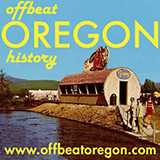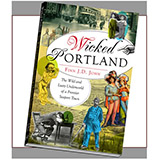NEWSFEATURE
The Willamette Valley's cackling goose wars
By FINN J.D. JOHN
March 2010
For the Native Americans living in the tundra around Alaska’s Yukon-Kuskokwim Delta, the sound of hundreds of cackling geese overhead is the sound of life.
For the grass-seed farmers of Oregon’s Willamette Valley, it’s the sound of financial ruin.
And for the government officials caught in the middle, it’s the sound of yet another rough day on the job.
Since the early 1990s, migratory cackling geese have been a major problem for mid-Willamette Valley farmers. Hundreds of thousands of the voracious birds now spend their winters in the valley. They fly from field to field, darkening the skies with rows of their ragged V formations. And they eat like a swarm of locusts.
“Ten geese will eat as much as a cow,” said Sweet Home-area farmer Alex Paul, whose wheat fields become home to thousands of the birds every year.
To try to keep the birds down, Paul has several local hunters working his property. Their goal is not to kill them all – there are far too many – but, rather, to encourage them to go someplace less dangerous, and leave Paul's crops alone.
Paul is lucky. His farm is outside the Willamette Valley Permit Zone. Inside the permit zone, geese can only be hunted on Wednesdays and on weekends, and bagged birds must be taken to a check station and examined before the hunter can take them home.
Even outside the zone, hunters have to take and pass a goose-identification test before they can get their hunting permits. Few hunters are willing to go through this additional hassle.
But it’s not a lack of hunters that’s at the heart of the farmers’ dilemma. It’s an international treaty. And it’s not clear whether anything can be done to make it better for them.
* * *
The cackling goose is one of the smallest wild geese around – sometimes no bigger than a very large mallard duck. They’re easily distinguished from the larger Canada goose by their smaller size, shorter neck and high-pitched, squealy honk. Like the Canada geese, they do their nesting and breeding in the far north and fly south each year for the winter.
In the north, the cacklers’ home is in the vicinity of the Yukon-Kuskokwim Delta, an enormous and swampy river delta the size of the entire state of Oregon located in the tundra along the west coast of Alaska.
In the south, the cacklers’ home is Alex Paul’s wheat field, and those of his neighbors.
But this is a relatively new thing. Until a dozen or so years ago, Willamette Valley fields like Paul’s were quiet and peaceful in the winter.
The roots of the farmers’ dilemma go back into the 1960s, when hunters all along the cacklers’ flyway had blanket permission to shoot as many honkers as they wanted. In those days, cackling geese weren’t often seen in the Willamette Valley. Most of them spent the winter in northern California, stopping to rest in the Klamath Basin and spending most of the winter in the Sacramento Valley. They had wintered there since ancient times. Just a few of them – less than 10 percent – were spending the season in Oregon’s Willamette Valley.
But as goose hunting got more popular, and hunting pressure increased, numbers of the diminutive honkers started to decline. Perhaps significantly, hunting pressure was particularly intense in northern California, where they became the subject of destination hunts with people actually coming to the flyway to experience the great migration, and to hunt its geese.
As a result, from a historic population estimated at 400,000, cackling goose numbers dipped below 50,000 in the late 1970s, and reached a frightening low of 26,000 in 1984.
Frightening, that is, for the Yupik and Athabaskan Native peoples living on the frozen Yukon-Kuskokwim Delta. The cackling geese occupied a vital link in their food supply: These were the first birds of the season to come to them. They came at a time when the tundra was thawing out into a layer of a few inches of soupy mud on top of hard-frozen earth. Setting out to hunt seals and other game was hopeless, and would be for weeks until the ground thawed enough for the moisture to drain. Without the flocks of big, tasty birds flying straight to them every spring, these Natives would go very hungry and might even starve.
Frightening, also, from a wildlife-management standpoint. No one wants to see a popular species go extinct.
So representatives of interested parties – state wildlife agencies, the national governments of Canada and the U.S., and conservation and hunting groups – met to plan a response.
The result was the Hooper Bay Plan of 1984, which became the Yukon-Kuskokwim Delta Goose Management Plan of today. Under the plan, everyone agreed to work toward a cackling goose population of 250,000 – far fewer than the Natives wanted, but enough, they agreed, to get them through the swampy spring.
Oregon representatives sat at the table in 1984, but didn’t worry much about the outcome. After all, cacklers were rare in Oregon. Sure, they flew over the state on their way to northern California, and a few stopped for the winter in the state, but for the most part, the birds were none of the Beaver State’s business.
But as time went by and the plan started working, Oregon wildlife workers noticed a disturbing thing: Apparently a disproportionate number of the surviving geese were Willamette Valley winterers. And as the population came back up, almost all the new geese preferred to winter in Oregon, not California.
Today, 80 percent of all cackling geese spend the winter in the Willamette Valley. There are still only 180,000 of them, so by the terms of the international goose plan, they have to be managed for population growth – meaning hunting is restricted.
This has many farmers angry. Although the cackling goose population is not huge, they’re almost all wintering in the same place, and enormous numbers of them fly around together – enhancing the illusion of superabundance. Also, there are six other species of goose that often flock with them, boosting total goose numbers in the valley by another 50,000 or so. How could something that swarms like a nest of hornets be rare and deserving of protection?
Hunters, too, find the situation frustrating. They’re allowed to bring home six geese per hunting day, but only two of those may be cacklers. Because there are four times as many cacklers as other geese, it’s very rare for a hunter to “bag the limit” before the two cacklers are shot, meaning they usually end up going home early.
“It’s hard for hunters to see why they can only shoot two cacklers when that’s all they see,” said Brandon Reishus, a game-bird biologist for the Oregon Department of Fish and Wildlife. “So we’ve got that hurdle in trying to help farmers protect their fields.”
To help take some of the pressures off the farmers, Oregon Department of Fish and Wildlife workers are actually farming fields in the wildlife refuges – as many as possible. These fields actually have crops planted in them, but not harvested, so that the geese will have a place to eat. But there’s still not enough land or crops to support the flocks that are coming to the valley today.
To complicate matters even more, one of the other six species of goose that winter in the valley – the dusky Canada goose – is in real trouble. These geese nest in what used to be a salt marsh in the Copper River Delta, and an earthquake there decades ago heaved the ground up, enabling numerous new predators to approach their nests and eat their young.
“Fortunately, cacklers and duskies are the easiest to tell apart – their voice is distinctively different,” said Reishus. “That allows us to even have a hunting season. If you couldn’t tell duskies from the others, it’s possible the feds wouldn’t even let us have a hunting season.”
But if dusky-goose populations drop to the level of an endangered species, the entire goose hunt in the Willamette Valley could come to a halt.
Today, the Willamette Valley goose program hobbles along, pleasing no one. The wildlife managers handling it, under pressure from hunters and farmers on one side and international law on the other, tend to be defensive and guarded.
“The biggest hurdle is just the balance,” said Reishus. “It probably will continue to be the biggest hurdle – just trying to balance the wants: sport hunters, people who don’t want any shot, farmers who want ‘em all gone, Natives (who want them all restored). At least we’d like them all to realize that everybody’s doing their best.”
Note: This article was prepared for a seminar led by Edward Humes in winter term 2010.






